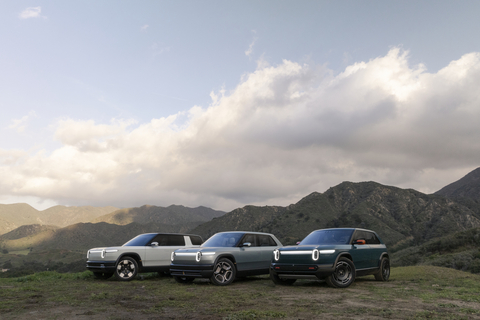Rivian Introduces R2, R3, and R3X Built on New Midsize Platform
- None.
- None.
Insights
The unveiling of Rivian's new R2 and R3 product lines represents a significant strategic move in the electric vehicle (EV) segment. The company's approach to leveraging its existing Normal, Illinois manufacturing facility for the production of the new models is a notable shift toward capital efficiency. This decision is expected to yield savings of over $2.25 billion compared to initial projections for the Georgia site, suggesting a more judicious use of capital resources. For investors, this could signal a stronger financial position and a potentially reduced risk profile for the company.
The announced production capacity of 215,000 units per year post-launch indicates Rivian's confidence in market demand for its vehicles. This capacity expansion aligns with the broader industry trend of scaling EV production to meet growing consumer interest. However, the market will be watching closely to see if Rivian can avoid past production challenges and meet these targets without compromising quality or delivery timelines.
Rivian's pricing strategy, with the R2 starting at around $45,000 and the R3 priced below that, positions the company to capture a broader customer base in the competitive midsize SUV and crossover segments. This pricing undercuts several competitors in the luxury EV market, potentially disrupting current market dynamics. The focus on cost-effective manufacturing and robust supply chain development is crucial, as these factors greatly influence the final pricing and market competitiveness of EVs.
Furthermore, the introduction of three motor variants and advanced features like a structural battery and autonomous capabilities reflects Rivian's commitment to innovation. The emphasis on frequent software updates is likely to appeal to tech-savvy consumers and aligns with the industry's shift towards vehicles that improve over time through over-the-air updates.
Rivian's use of sustainable materials in the R2 and R3 models underscores the company's commitment to environmental responsibility, a factor increasingly important to consumers. The company's design philosophy, which integrates sustainability with functionality, may enhance its brand image and appeal to a segment of the market that prioritizes eco-friendly products. The use of high-pressure die castings and a structural battery unit that also serves as the vehicle floor demonstrates an innovative approach to reducing material use and vehicle weight, which can lead to improved energy efficiency and performance.
The choice of Rivian to offer a structural battery with improved energy density suggests a potential reduction in the environmental impact of battery production. By improving the range and charging speed, Rivian may also be addressing one of the key consumer concerns about EV adoption, thereby potentially accelerating the transition to sustainable transportation.
R2 Starting Around

Rivian introduces its midsize platform family: R2, R3 and R3X. (Photo: Business Wire)
R2 is Rivian’s all-new midsize SUV delivering a combination of performance, capability and utility in a five-seat package optimized for big adventures and everyday use. The silhouette and face of R2 are distinctly Rivian. The powered rear glass fully drops into the liftgate for carrying all types of gear and enabling a unique open air driving experience. The interior is designed for ease-of-use, while being uniquely Rivian through a combination of inviting design and premium, sustainable materials that are easy to clean. R2 also features first and second row seating that fold completely flat, for gear, cargo, and even car camping.
R3 is a midsize crossover that is tidy on dimensions but delivers big in terms of performance, off-road capability, passenger comfort, and storage. R3X is a performance variant of R3 offering even more dynamic abilities both on and off road. The design of the exterior and interior of R3 are inviting and iconic. R3 demonstrates the scalability of Rivian’s brand across different form factors while continuing to be immediately recognizable.
R2 and R3 will feature two battery sizes. The larger pack will achieve over 300 miles of range on a single charge and offer 0-60 mph acceleration in under 3 seconds for the quickest powertrain configuration.
Pricing for R2 is expected to start around
“I have never been more excited to launch new products – R2 and R3 are distinctly Rivian in terms of performance, capability, and usability, yet with pricing that makes them accessible to a lot of people,” said Rivian Founder and CEO RJ Scaringe. “Our design and engineering teams are extremely focused on driving innovation into not only the product features but also our approach to manufacturing to achieve dramatically lower costs. R2 provides buyers starting in the
All-New Platform
Developed to deliver amazing performance, range, and cost efficiency, R2 and R3 were built on an all-new midsize vehicle platform. This platform consolidates and eliminates parts thanks to intelligent design, including the use of high pressure die castings, a structural battery unit where the top of the pack also serves as the floor, and closure systems that dramatically reduce complexity. R2 and R3 also utilize Rivian’s drive unit platform and internally developed network architecture, computer topology and software stack.
R2 and R3 Highlights
- Three Motor Variants: Leveraging Rivian’s in-house drive unit platform and technology, there will be Single-Motor (RWD), Dual-Motor (AWD), and Tri-Motor (two motors in rear and one in front) configurations, with the quickest configuration delivering 0-60 mph in under 3 seconds.
- Structural Battery: Utilizes an all-new 4695 cell that offers significant improvements in energy density and output, estimated to deliver over 300 miles of range on a single charge for both R2 and R3.
-
Fast Charging: DC fast charging is compatible with both NACS (native) and CCS (with adapter), charging from
10% to80% in less than 30 minutes. - Self Driving: Utilizing Rivian’s new perception stack featuring 11 cameras, five radars and a more powerful compute platform, R2 and R3 will provide dramatically enhanced autonomous capabilities.
- Ever improving and expanding features: As with all Rivian vehicles, Rivian has developed its network architecture, topology of computers and associated full software platform to facilitate frequent software updates – the headroom for feature growth over time is extremely exciting.
Intentional Design
R2 and R3 demonstrate how Rivian’s design language adapts to different vehicle sizes and form factors.
“Our R1 flagship vehicles served as our handshake with the world – with R2 and R3 our obsessive goal is to stay true to Rivian’s product attributes while making our products accessible to a lot more people,” said Rivian Chief Design Officer Jeff Hammoud. “Through a tight integration of hardware, software and human-centered design, we designed R2 by balancing form with function, while building on our inviting and iconic design language.”
R2’s design prioritizes:
- Adventure: R2's four passenger windows and rear powered glass drop fully, and the powered rear quarter windows vent to invite the outside in, creating a unique open-air driving experience. With R3, its hatch-style design maximizes space while keeping a sporty, athletic silhouette.
- Space: With an extreme focus on rear passenger legroom, even long trips in R2 and R3 are comfortable. With the seats folding completely flat, ample sized front and rear trunks, and additional interior storage, there is space for everyone and all their gear.
- Refined Touches: Rivian’s new steering wheel with integrated haptic control dials makes it easier to stay focused on the road ahead. Materials balance durability and sustainability with easy-to-clean textiles and finishes.
R2's package makes the best of Rivian available at a significantly lower price point. Customers in the
R2 Production to be Launched in
To enable R2 to be launched earlier and with a considerable reduction in the capital required for its launch, Rivian plans to start production of R2 in its existing
To summarize:
-
Improved capital efficiency: Total savings estimated to be over
$2.25 billion Georgia site. The savings are expected to come from capital expenditures, product development investment, and supplier sourcing opportunities. - Improved cash visibility: Cash, cash equivalents, and short-term investments expected to be sufficient to fund operations through the start of R2 production.
- R2 planned start of production: The timing has been pulled forward to now be in first half of 2026.
-
Total expected
Normal capacity following R2 launch and plant changes: 215,000 units of total annual capacity across R1T, R1S, EDV, RCV, and R2.
About Rivian:
Rivian (NASDAQ: RIVN) is an American automotive manufacturer that develops and builds category-defining electric vehicles and accessories. The company creates innovative and technologically advanced products that are designed to excel at work and play with the goal of accelerating the global transition to zero-emission transportation and energy. Rivian vehicles are built in
Forward-Looking Statements:
This press release contains forward-looking statements within the meaning of the Private Securities Litigation Reform Act of 1995. We intend such forward-looking statements to be covered by the safe harbor provisions for forward-looking statements contained in Section 27A of the Securities Act of 1933, as amended, and Section 21E of the Securities Exchange Act of 1934, as amended. All statements contained in this press release that do not relate to matters of historical fact should be considered forward-looking statements, including without limitation statements regarding the timeline for the start of production of R2 and the expansion of production capacity in
We have based these forward-looking statements largely on our current expectations and projections about future events and financial trends that we believe may affect our business, financial condition, and results of operations. Forward-looking statements involve known and unknown risks, uncertainties and other important factors that may cause our actual results, performance, or achievements to be materially different from any future results, performance, or achievements expressed or implied by the forward-looking statements, including, but not limited to, the important factors discussed in Part I, Item 1A, “Risk Factors” in our Annual Report on Form 10-K for the year ended December 31, 2023, and our other filings with the Securities and Exchange Commission. The forward-looking statements in this press release are based upon information available to us as of the date of this press release, and while we believe such information forms a reasonable basis for such statements, such information may be limited or incomplete, and our statements should not be read to indicate that we have conducted an exhaustive inquiry into, or review of, all potentially available relevant information. These statements are inherently uncertain, and investors are cautioned not to unduly rely upon these statements. While we may elect to update such forward-looking statements at some point in the future, we disclaim any obligation to do so, even if subsequent events cause our views to change.
DISCLAIMERS:
Actual vehicle capability will depend on selected options and trim. Ranges are preliminary manufacturer estimates based on EPA test cycle and are not official EPA values. Performance estimates vary based on battery pack, tire, drive modes, weather, driving behavior, vehicle condition and load, and battery age. Charging rate may be limited by charger capacity and other factors.
View source version on businesswire.com: https://www.businesswire.com/news/home/20240307349103/en/
Source: Rivian







